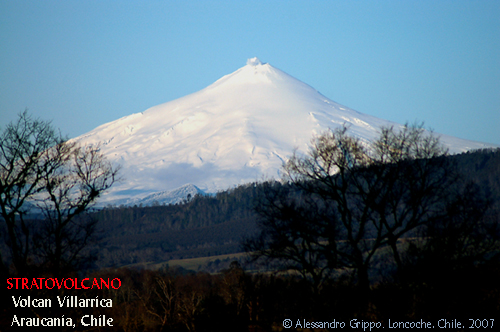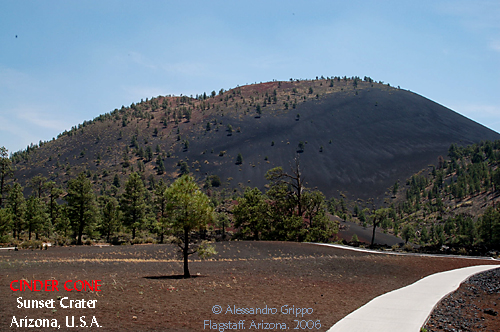 |
Alessandro Grippo, Ph.D.
Examples illustrating the three main kinds of volcanic buildings:
|
 If measured from the bottom of the ocean, where it started building on the top of a hot spot, this is the tallest mountain of the world. At 4169 m (13,678 feet) above sea level, this mountain would make its figure with peaks like those of the Alps or of the Sierra Nevada.
The composition of the lava at this hot spot allows for a very low viscosity. Continuous, successive flows are responsible for the building, over time, of the broad structure characetristic of shield volcanoes.
© (Alessandro Grippo, 2005) |
Mauna LoaHawai'i, HI U.S.A. |
|
 With its snow-capped top and a small cloud at the edge of the crater, Volcan Villarrica in Chile is the archetype of composite volcanoes: an almost perfect cone, Volcan Villarrica has been built by an alternations of lava flows and pyroclastic explosions.
© (Alessandro Grippo, 2007) |
Volcan VillarricaAraucania CHILE |
Stratovolcano or
Composite Volcano |
 Rising from the banks of Lake Managua, majestic Volcan Momotombo clearly shows the characteristical conical shape of stratovolcanoes built above subduction zones. At this location, the oceanic crust of the Cocos Plate is subducting underneath the Caribbean plate.
To the far right is the much smaller sister cone of Volcan Momotombito ("Little Momotombo"), making its own little island at the edge of Lake Managua.
Notice the dark color, brown to black in spots, of the beach sand along the banks
of Lake Managua, a clear indicator of its volcanic origin.
© (Alessandro Grippo, Puerto Momotombo, Nicaragua, 2009) |
Momotombo and MomotombitoLeon Viejo (Puerto Momotombo) NICARAGUA |
Stratovolcano or
Composite Volcano |
 Close to the southern end of the Cascades, Mount Shasta appears suddenly among the mountains of northern California. Its shape and its top blown off by an explosion are witnesses to its legacy as a composite volcano.
© (Alessandro Grippo, northern California, 2009) |
Mount ShastaWeed, CA U.S.A. |
|
 At the edge of a vast volcanic field in northern Arizona, Sunset Crater is built by loose, unconsolidated pyroclastic materials. Protected within the boundaries of Sunset Crater National Monument, its peak is the biggest in the area, while still looking like very small when compared to a shield volcano or a composite volcano.
© (Alessandro Grippo, 2006) |
Sunset CraterFlagstaff, AZ U.S.A. |
|
 A smaller size cinder cone, only a few hours away by car from Santa Monica:
Amboy Crater, in the Mojave desert of southern California.
The Geology 35 class has been at this location during Spring 2008.
During the field trip, students have been able to hike to the volcano and then climb up to the crater's edge and to its bottom. See images of that trip here.
© (Alessandro Grippo, 2008) |
Amboy CraterAmboy, CA U.S.A. |
|
| |

